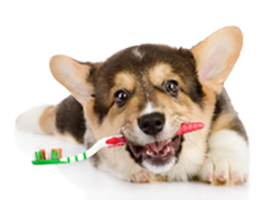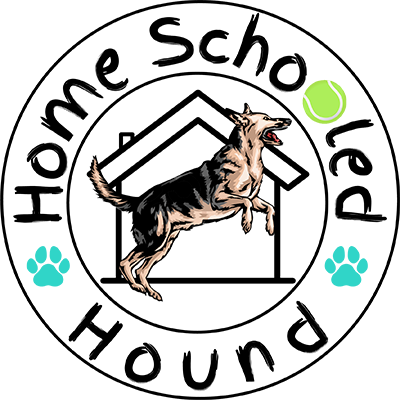Last week, we discussed the stress that canines can experience when they are groomed or visit a veterinarian’s office. Restraint, handling, grooming, and veterinary care are all a part of keeping an animal healthy, but it doesn’t need to be stressful. By using desensitization and counter-conditioning techniques, we can help our canines not only tolerate these experiences, but even happily volunteer to be a participant in their own care!

Desensitization is a slow introduction to something new, or to something that the animal previously found to be scary. In other words, owners expose the animal to something in small doses. This helps the animal get acclimated to the experience or object. It’s important to note the starting point of the desensitization process. Start wherever the dog is comfortable. Let’s say we have a dog that hates being picked up. If the dog isn’t comfortable with the restraint of being picked up, that’s where we would begin. With the dog standing in front of you, simply place one arm over your dog’s back. After several repetitions, place your arm around your dog, then apply a bit of pressure as though you are about to pick up your dog, etc. If your dog is comfortable with restraint, but is stressed about being raised off the ground, then that would be the starting point. Place your arm around your dog as though you were going to pick him/her up, but only raise the front feet of the ground an inch or two and place the dog right back down again. The next steps would be to pick the dog up and raise all four feet off the ground about an inch for a split second and place the animal right back down again. As you can see, breaking up the sequence into tiny portions and getting the dog used to small increments is key. One thing I like to remind my clients of that it is VERY IMPORTANT to remember: the dog must be comfortable with each step before moving on to the next. This is going to take patience and a lot of repetition. Even if you think the process is going too slowly, remember that slow=fast when you are working to acclimate your dog to something. Going too fast and inducing fear will only set the process back to the beginning.
It’s important to note that in most cases, desensitization cannot be used alone. This is because it is not enough for the animal to be exposed to something where “nothing bad” happens. One reason for this is perhaps the animal didn’t have a bad experience this time he was brushed for example, but had a painful tangle pulled 6 months ago. Fear is an emotion which becomes quickly and deeply ingrained, so the dog can still experience emotional arousal when he merely sees the brush due to the anticipation of something bad happening. This emotional arousal causes stress hormones to be released throughout the animal’s body which, in turn, causes the physiological symptoms we see such as panting, increased heart rate, and other such symptoms. This negative feeling causes the animal to create a negative association with the experience or object. The same applies even if the animal is being introduced to something for the first time. You may see absolutely nothing wrong, but your dog may be perceiving something very different. For some reason, your dog may be experiencing fear. Thus, a negative association can be created. For example, I am terrified of spiders. I’ve never been mortally wounded by one, and one might say that in my every exposure to spiders “nothing bad” has ever happened. However, that doesn’t alter the fact that I am terrified of spiders. Now, if I was a comfortable distance away from one and every time it crossed my path a $100 bill fell from the sky, I would feel very differently about spiders. I would likely even get to the point where I could get very close to one, and maybe eventually even hold one. Granted, it would be a process and wouldn’t happen overnight, but it could certainly happen. Therefore, we should make every effort to help “something good” happen when we are using desensitization. This is why it must be paired with classical conditioning.
 Classical conditioning is referred to as “counter-conditioning” if we are trying to help the animal overcome a fear of something. It’s much easier to create a positive association when the dog has yet to form a fear then it is to change the dog’s emotional response. This is why it is always so highly recommended to socialize puppies and positively expose them to new things. Classical conditioning is a Pavlovian concept. I won’t go into a lengthy explanation, but to learn more about Pavlov’s work, a Google search will bring up a fascinating description. Pavlov used the sound of a bell (a sound that was previously neutral), but by pairing the ring of the bell with food, the dogs eventually got excited when they heard the bell and even started salivating when food wasn’t present but the sound was heard. This is the same concept we can use to evoke a positive emotional response in our dogs about anything we need to do for their care. Basically, all that classical conditioning paired with desensitization means is that we give the dog a really tasty morsel of food (dry kibble or milk bones don’t count – try something of high value like cheese or real meat instead) after every repetition of each small step in the desensitization process.
Classical conditioning is referred to as “counter-conditioning” if we are trying to help the animal overcome a fear of something. It’s much easier to create a positive association when the dog has yet to form a fear then it is to change the dog’s emotional response. This is why it is always so highly recommended to socialize puppies and positively expose them to new things. Classical conditioning is a Pavlovian concept. I won’t go into a lengthy explanation, but to learn more about Pavlov’s work, a Google search will bring up a fascinating description. Pavlov used the sound of a bell (a sound that was previously neutral), but by pairing the ring of the bell with food, the dogs eventually got excited when they heard the bell and even started salivating when food wasn’t present but the sound was heard. This is the same concept we can use to evoke a positive emotional response in our dogs about anything we need to do for their care. Basically, all that classical conditioning paired with desensitization means is that we give the dog a really tasty morsel of food (dry kibble or milk bones don’t count – try something of high value like cheese or real meat instead) after every repetition of each small step in the desensitization process.
 For example: let’s say my dog is afraid of being brushed. The process would look something like this:
For example: let’s say my dog is afraid of being brushed. The process would look something like this:
- Show the dog the hair brush and offer food, then hide the brush again.
- Reach a small bit towards the dog with the hairbrush and feed.
- Get closer and closer, feeding the dog every time.
- Barely touch the dog with the brush for a split second and feed.
- Do a one inch stroke with the hairbrush on your dog’s favorite “scratch me” spot and feed.
- Do longer and longer strokes, feeding every time.
Each step is done many many times and the dog should feel completely comfortable before moving on to the next step. You can do this with anything your dog might be uncomfortable with. You can do this with nail clippers, electric razors, ear cleanings, restraint, vet visits, etc. You are not only building a positive association with these experiences, but you are making it predictable. The animal knows exactly what’s going to happen next. There is safety in predictability, so make these experiences predictable and fun! Show your dog that the world is a safe and fun place, and you’ll not only remove the stress from your dog’s life, but from yours as well.
Happy Training!
Sarah Rodriguez

Join Our Expert Dog Trainer Sessions Today
Ready to witness remarkable transformations in your dog’s behavior? Join us on this journey of positive reinforcement and effective training. Let’s create a lasting bond with your furry companion – sign up for a session now and experience the joy of a well-trained, happy dog!



